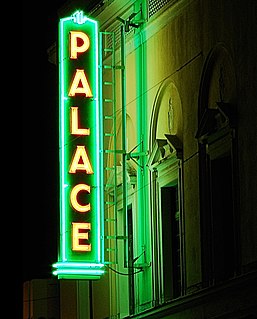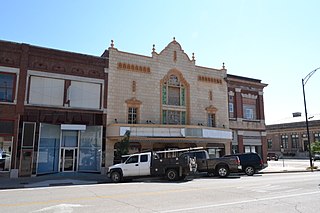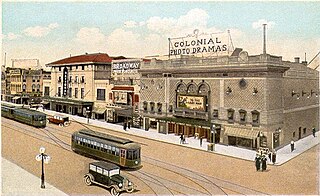
This is intended to be a complete list of the properties and districts on the National Register of Historic Places in Fairfield County, Connecticut, United States. The locations of National Register properties and districts for which the latitude and longitude coordinates are included below may be seen in an online map.

The Palace Theater is a movie theatre in downtown Hilo, Hawai'i in the United States of America. Built in 1925, the theater is one of the more prominent public buildings constructed in Hilo in the early 20th century. Architects Davis & Fishbourne designed the theater in the Beaux-Arts style. The two-story building has five bays on its front facade; a metal marquee divides the two stories. The three central bays feature broken pediments and decorative urns above the second-floor windows. A parapet with a balustrade runs along the top of the building. After the original theater closed, the Palace reopened in 1998 as an arthouse.

The Grand Opera House, also known as The Grand or Masonic Hall and Grand Theater, is a 1,208-seat theater for the performing arts in Wilmington, Delaware, United States. The four-story building was built in 1871 by the Delaware Grand Lodge of Masons to serve as a Masonic Temple and auditorium. The construction cost was $100,000. It was designed in Second Empire style by Baltimore architect Thomas Dixon and incorporates symbolism from Freemasonry into the cast-iron facade. Its central pediment contains an Eye of Providence.

The Rose Blumkin Performing Arts Center or The Rose, also known as the Astro Theater, originally opened as The Riviera. It is located in downtown Omaha, Nebraska. Built in 1926 in a combination of both Moorish and Classical styles, the building was rehabilitated in 1986.
The National Register of Historic Places listings in Syracuse, New York are described below. There are 109 listed properties and districts in the city of Syracuse, including 19 business or public buildings, 13 historic districts, 6 churches, four school or university buildings, three parks, six apartment buildings, and 43 houses. Twenty-nine of the listed houses were designed by architect Ward Wellington Ward; 25 of these were listed as a group in 1996.

The Central Theater was built in Ely, Nevada from 1939 to 1941. The Art Deco style cinema was built by Percy and Warren Hull after they were denied permission to expand Ely's Capital Theater, which opened in 1916. Originally it was built as a 725-seat theater. The Central is unusual in a town where most of the structures were built in the boom times of the early 20th century. The one story building features a vertical CENTRAL neon sign over the marquee. The interior features curved surfaces and is in a good state of preservation.

The Ely LDS Stake Tabernacle was built by the Church of Jesus Christ of Latter-day Saints in 1927-1928 as a church and community center in Ely, Nevada. The two-story Colonial Revival building is now owned by White Pine County and is used as a community meeting hall. The contractor for the project was Joseph Don Carlos Young, grandson of Brigham Young.

The Rialto Theater in Casper, Wyoming was built as the New Lyric Theater in 1921. It was constructed with 800 seats by Henry Brennan who had a successful Vaudeville house, on which he based the new cinema. He almost immediately sold the building in 1922 to new owner E.J. Schulte who invested $50,000 in a remodeling project designed by Casper architects William Dubois and Leon Goodrich. The reopening in 1922 featured the William C. deMille movie Nice People, a silent film that was accompanied by the Chicago Netto Ladies Orchestra. In 1928 the Rialto began to show talkies.

Strand Theatre was a historic theater located at Ithaca in Tompkins County, New York. It was built in 1916–1917 in the Tudor Revival style.

The Booth Theater is a historic movie theater located at 119 W. Myrtle St. in Independence, Kansas. The building was constructed in 1911 and renovated for use as a movie theater in 1926–27. The redesigned theater was the first in Independence to be designed specifically for use as a movie theater. The Boller Brothers, an architectural firm known for their theater designs, designed the theater in a mixture of the Spanish Renaissance and Italian Renaissance Revival styles. The theater showed films until its closure in 1980.

The National Theater is a historic theater in Richmond, Virginia. Part of a city block along the 700 block of Broad Street once known as Theatre Row, it is the only surviving auditorium of the row.

The Fox Theatre in Redwood City, CA opened in 1929, was remodeled in 1950, and was listed on National Register of Historic Places in 1994.

The State Theatre is a Moderne style cinema in Red Bluff, California, USA. It was built in 1945-46 to a design by architects Alexander A. and Mackenzie A. Cantin, replacing a theater that had burned two years before. It provided the only public stage in Tehama County until 1991, and was the only cinema until 1993. It is notable as one of the few theaters to be built in the United States during World War II.

The Vocational-Agriculture Building in Lovelock, Nevada, located at 1150 Elmhurst Ave. is a historic Moderne-style building that was built in 1941. It is listed on the National Register of Historic Places.

The Olcovich–Meyers House, at 214 W. King St. in Carson City, Nevada, is a historic, well-preserved house that was built during 1874–75 with Late Victorian architecture. It was listed on the National Register of Historic Places in 1993. The listing included two contributing buildings.

The George L. Sanford House, at 405 N. Roop St. in Carson City, Nevada, United States, was built in c.1910. It includes Bungalow/craftsman, Stick/Eastlake, and Second Empire architecture. It was listed on the National Register of Historic Places in 1994; the listing included two contributing buildings.
Russell Mills (1892-1959) was an American architect based in Reno, Nevada. A number of his works are listed on the U.S. National Register of Historic Places. He "spent early years" in the Philippines. He worked as a draftsman for noted architect Frederic DeLongchamps.

The Veterans Memorial Elementary School, also known as Veterans Memorial STEM Academy, at 1200 Locust St., is a public elementary school in Reno, Nevada, operated by the Washoe County School District. It occupies a historic Moderne-style building dating from 1949 that was designed by Nevada architect Russell Mills. It was listed on the National Register of Historic Places in 1995. It was deemed significant "for its role in the local history of education" and "for its Art Deco/Moderne style of architecture by a prominent local architect, Russell Mills."
The Kilauea Plantation or Kilauea Sugar Plantation was a large sugarcane plantation on the north side of Kauai island, Hawaii, including the community of Kilauea, Hawaii. It was owned and operated by the 1880-incorporated Kilauea Sugar Company, which became the Kilauea Sugar Plantation, Co. from 1899 on. The original property was bought by an American, Charles Titcomb, from Kamehameha IV by 1863 who used it for cattle ranching. It was sold to Englishmen John Ross and E.P. Adams, who also leased additional land from Titcomb. Ross and Adams planted sugarcane, then incorporated a firm. It was operated as a plantation from 1880 to 1971.

The Varsity Theatre is a historic movie theater in Martin, Tennessee, USA. The building is listed on the National Register of Historic Places.



















